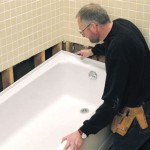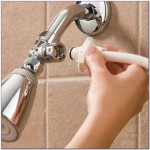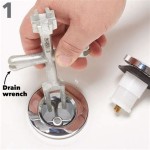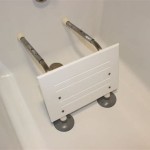Do You Need A Permit To Install A Bathtub? Understanding the Regulations
Embarking on a bathroom renovation project, especially one that involves replacing or installing a new bathtub, frequently leads to the question of permits. Navigating the permits and regulations surrounding plumbing and structural changes in residential buildings can be intricate. The necessity of obtaining a permit for bathtub installation is not a universal constant; it varies significantly depending on location, the scope of the project, and local building codes.
The primary purpose of building permits is to ensure that construction work adheres to established safety standards and local regulations. This process protects homeowners, future residents, and the community by guaranteeing that structures are built and modified in a safe and compliant manner. These regulations cover aspects such as plumbing, electrical wiring, structural integrity, and accessibility. Failure to obtain necessary permits can result in fines, project delays, and even the requirement to undo completed work. Therefore, thorough investigation into local requirements is crucial before beginning any bathtub installation project.
Key Point 1: Local Building Codes and Regulations
The first and most important step in determining whether a permit is required for bathtub installation is to consult the local building codes and regulations of the city or county in which the property is located. These codes are typically administered by a local building department or planning office. Contacting this department directly is the most reliable way to obtain accurate and up-to-date information regarding permit requirements.
Building codes are designed to ensure the safety and structural integrity of buildings. They cover a broad range of construction activities, including plumbing, electrical, and structural work. The specific requirements for permits related to bathtub installations can be found within these codes, often under the plumbing or building sections. Some jurisdictions may have specific guidelines for bathroom renovations, while others may address bathtub installations as part of broader plumbing regulations.
It is important to note that building codes can vary significantly between different municipalities and counties. What is permissible in one area may not be allowed in another. Factors such as population density, environmental concerns, and the age of the building stock can influence the stringency of local building codes. Therefore, relying on general information or anecdotal evidence about permit requirements is not advisable. The only way to be certain is to consult the relevant local authorities directly.
In addition to building codes, homeowners should also be aware of any homeowners association (HOA) rules or covenants that may apply to their property. HOAs may have their own requirements for renovations, which could include obtaining approval for any exterior changes or modifications to common areas, even if the project is primarily internal. Failing to comply with HOA regulations can result in fines or legal action.
Key Point 2: Scope of the Bathtub Installation Project
The requirement for a permit often hinges on the scope of the bathtub installation project. A simple replacement of an existing bathtub with a new one of the same size and in the same location may not require a permit in some jurisdictions. However, more extensive projects that involve altering the plumbing, electrical wiring, or structural components of the bathroom are more likely to require a permit.
Specifically, any modifications to the existing plumbing system, such as rerouting water lines, adding new drains, or changing the type of plumbing materials, typically necessitate a permit. Plumbing permits are required because plumbing work involves the water supply and drainage systems, which are critical for public health and safety. Improperly installed plumbing can lead to leaks, water damage, and potential contamination of the water supply.
Similarly, any modifications to the electrical wiring, such as installing new outlets, changing the wiring for a whirlpool tub, or relocating existing electrical fixtures, will likely require an electrical permit. Electrical work is subject to strict regulations due to the risk of electrical shock and fire. Only qualified electricians are typically allowed to perform electrical work, and inspections are required to ensure that the work is done safely and in accordance with electrical codes.
Structural alterations, such as moving walls, changing the floor plan, or reinforcing the floor to support a larger bathtub, always require a permit. Structural work affects the stability and integrity of the building, and permits are necessary to ensure that the changes are made in a safe and compliant manner. Structural engineers may be required to review the plans and provide calculations to demonstrate that the proposed changes meet structural requirements.
Even if the project seems minor, if it involves any of the above alterations, it is advisable to check with the local building department to determine whether a permit is necessary. Ignoring permit requirements can lead to costly fines and delays, and may even require undoing the completed work.
Key Point 3: Potential Consequences of Not Obtaining a Permit
Undertaking a bathtub installation project without the required permits can lead to a range of negative consequences. While it may seem tempting to avoid the time and expense of obtaining permits, the potential risks and penalties often outweigh the perceived benefits.
One of the most common consequences of unpermitted work is the imposition of fines. Local building departments have the authority to issue fines for violations of building codes, and these fines can be substantial. The amount of the fine typically depends on the severity of the violation and the cost of the unpermitted work. In some cases, fines can accumulate daily until the violation is corrected.
In addition to fines, homeowners may be required to stop work on the project and obtain the necessary permits retroactively. This can be a time-consuming and expensive process, as it may involve submitting plans, undergoing inspections, and potentially redoing some of the work to meet code requirements. The delay in completing the project can be frustrating and disruptive, especially if the bathroom becomes unusable during the permit process.
Furthermore, unpermitted work can create problems when selling the property. During a real estate transaction, buyers often conduct inspections to identify any potential issues with the property. If unpermitted work is discovered, it can raise red flags and potentially deter buyers. The seller may be required to disclose the unpermitted work and obtain the necessary permits before the sale can be completed. This can delay the sale and reduce the property's value.
Insurance coverage can also be affected by unpermitted work. If a homeowner files a claim for damage related to unpermitted alterations, the insurance company may deny the claim. Insurance policies typically require that all work be done in accordance with local building codes, and unpermitted work that does not meet these codes may be considered a violation of the policy. This can leave the homeowner responsible for the cost of repairs or damages resulting from the unpermitted work.
Finally, unpermitted work can pose safety risks to occupants and future residents of the building. Building codes are designed to ensure the safety and structural integrity of buildings, and unpermitted work that does not meet these codes may be unsafe. Problems such as faulty wiring, inadequate plumbing, or structural instability can lead to fires, water damage, and even structural collapse. Protecting the safety of the occupants should be a primary consideration when undertaking any renovation project.
Therefore, it is always advisable to obtain the necessary permits before starting a bathtub installation project. While the permit process may seem cumbersome, it is ultimately a worthwhile investment that can protect homeowners from potential fines, delays, insurance problems, and safety risks.
The process of obtaining a permit typically involves submitting detailed plans of the proposed work to the local building department. These plans should include information such as the location of the new bathtub, the dimensions of the bathroom, the type of plumbing and electrical work that will be performed, and any structural alterations. The building department will review the plans to ensure that they comply with local building codes.
Once the plans have been approved, a permit will be issued. The permit must be posted at the job site and remain visible throughout the duration of the project. The building department may conduct inspections at various stages of the project to ensure that the work is being done in accordance with the approved plans and building codes.
Homeowners can typically apply for permits themselves, or they can hire a licensed contractor to do so on their behalf. Hiring a contractor can be beneficial, as they are familiar with the permit process and can ensure that the plans are prepared correctly and that the work is done in compliance with building codes. However, it is important to choose a reputable and licensed contractor who has experience with bathtub installations and is familiar with local building codes.
Navigating the complexities of building codes and permit requirements can be challenging, but it is an essential part of any bathtub installation project. By consulting local building departments, understanding the scope of the project, and obtaining the necessary permits, homeowners can ensure that their bathtub installation is done safely, legally, and in compliance with all applicable regulations. This will protect their investment, prevent potential problems, and ensure the safety and well-being of their families and communities.

Do You Need A Permit To Replace Bathtub Bathwraps

Do You Need Permits To Remodel A Bathroom Sweeten Com

Do I Need A Permit To Remodel My Bathroom In Atlanta

Why Do I Need A Permit For My Bathroom Project One Week Bath

Do You Need Permits For Your Bathroom Remodeling Project

Permits For Bathroom Remodeling Projects Complete Guide

Do You Need A Permit For Bathroom Remodel Understanding Requirements

Permits For Bathroom Remodeling Projects Complete Guide

Do You Need A Permit For Bathroom Remodel Understanding Requirements

Do You Need A Permit To Remodel Bathroom In Houston







